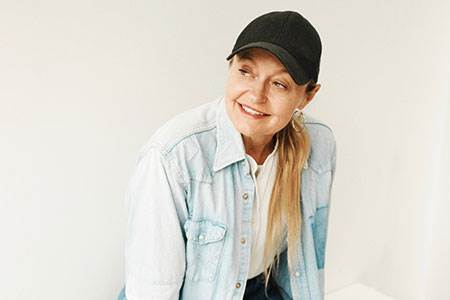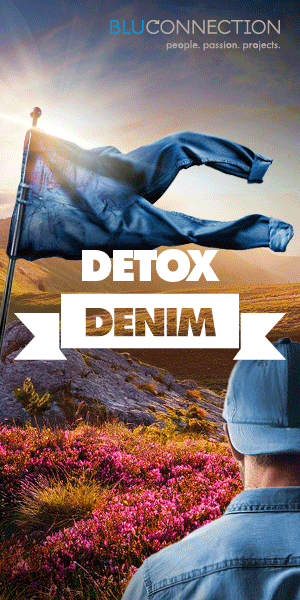Extreme thinking

Denim consultant Malin Ekengren sees trends evolving with super-wide-leg jeans and the return of the skinny fit. Fibre blends and washes will evolve as designers think of creative ways to revamp style while adding substance.
An important part of my job is analysing and interpreting trends. We have seen a lot of amazing denim in the recent runway shows, I think we're seeing a shift towards two extreme opposites, both for fits and for washes. On one hand, simple, beautifully executed dark washes, authentic and classic, or on the other hand very intense, tinted, highly worked or lasered patterns, washes and treatments. These two extremes will also filter into styles: we’ve seen the refresh of the low-waist skinny on the catwalk and that will sit alongside the large, super extreme, baggy wide-leg silhouettes that have been around for a while.
I love seeing the redefined essence of a five-pocket jean, and it’s especially interesting to see the return of the low-waisted skinny jean. This new reiteration is not like previous versions, fabric-wise. This is the time for new stretch fabrics and we will see innovative stretch constructions, with regenerative bases and different fibre mixes. The customer wants them to feel like a second skin, bounce back, hold in but still look like real denim.
The 90s casual, slouchy, oversized look will remain key; the extra wide-leg jean and the big-volume looks will need new fabrics with the right drape. The look and feel as well as the content of the fabric will have an impact on what designers choose, so this could include blending a recycled cellulosic into the cotton, making that oversized look softer and contemporary. We will also see this extreme curved, almost sculptural jean, which I love, replacing the barrel jean. That type of structured silhouette will in turn need another type of fabric base,more textured, heavier and non-stretch.
We are seeing minimal wash treatments on beautiful dark base fabrics come through, but also hand-crafted looks with micro-embellishments or subtle laser detailing. We've seen quite a lot of clever coatings and metallics on fabrics with a simple main wash. We will continue to see new textures: wash-wise we see needle-punch and bouclé looks to more extreme laser effects and textured fabrics. Slubby yarns, raised twills and orange peel-look fabrics are also coming through.
In terms of washing and dye trends, we’re returning to a deep classic indigo colour to mimic the rigid look, also for stretch, especially noticed in the polished and tailored denim out there. Blending classic denim with luxe treatments creates cleaner premium looks, which I love. I have always liked that raw Japanese selvedge look but this new rigid look also lends itself really well to the new stretch qualities.
While some of these trends are currently at runway stage, commercial versions will be in the market soon, everything filters down so quickly. High-end brands are tapping into a younger generation of designers who create what they want to wear and what they see on the street.
Fabric-first approach
My approach to denim design is to work with a well-constructed fabric, but mix the functionality of the fabric with a thoughtful design and the construction of a beautifully made jean. When I started out in my career, often the types of fabrics we wanted were not readily available. When I worked at Levi’s, for instance, we would develop the fabrics in-house and mill direct. Now the mills are so far ahead and they develop newness in a more comprehensive way than they did then.
My personal preference has always been non-stretch fabrics, mainly because it’s what I wear daily but also because they can carry the beautiful authentic washes that I like creating, such as the 60s/70s look. I do look at newer fibres and especially like the regen cotton coming through and fabrics with post-consumer content. The premium denim sector is already using a wide selection of these type of fabrics alongside Japanese bases and I’m hoping they will filter down to the wider markets quicker.
I love seeing what the younger generation of creatives are doing with denim. They show great ingenuity, finding unexpected ways of reusing materials, piecing together and upcycling to create newness that’s really exciting. As someone who’s been in the industry a while, you have your favourite cuts, fabrics and mills, but this new gen can be much more open-minded and without creative boundaries. Maybe they don't have the same emotional connection to traditional cotton and are open to other fibres?
There’s so much excitement around new fibres, but there’s always a question of how we can explain these to the consumer. Sustainability can be quite tricky to grasp; it needs to be straight-up and factual. We need to widen the audience so that it’s not just a small group who can make choices around sustainability, because they may be better informed or have the financial ability to do so. Even for myself, after having been vegetarian, I buy organic produce, especially vegetables and meat. With the food industry, the benefits are clearer: showing people why it matters is when it will hit home. Brands need to align in values and go beyond the price tag, only then will we reach a wider understanding.
In the latter part of my career, I've focused on organic cotton. Remember, organic cotton is such a tiny fraction of the global annual production, which is worrying because growing and producing traditional cotton really takes a toll on the planet. We need to move towards more organic cotton and less-harmful alternatives: linen, flax and similar fibres, that’s something that we really need to push for.
The future of denim needs transparency and accountability, and a push towards circular products that can be traced from start to finish. Of course, we all want it to look great and last longer, but can it do good as well? There's so much opportunity to innovate but this needs to start with challenging the norm at the very beginning of the process: when we design.
Malin Ekengren is a denim design consultant, starting her career at Levi’s and Gap; holding senior denim and consultancy roles at Celine, Marc Jacobs, Jigsaw and Saint Laurent, among others. She is currently working with UK, European and US brands through her design consultancy Malin Denim and lives in London with her husband, son and cat.
Photo: Bex Ashton













